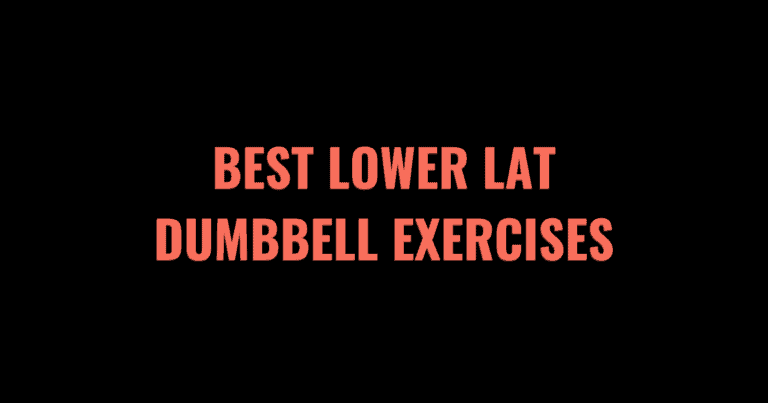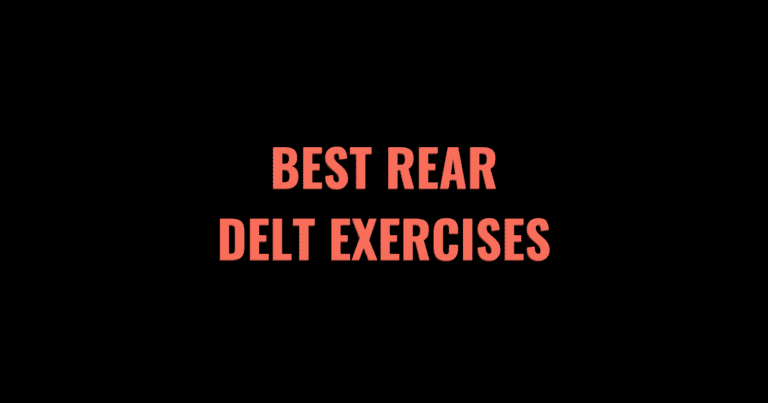Are you searching for the most effective way to build bigger, stronger traps? The traps are a large muscle group that spans the entire upper back. The trapezius muscle is divided into three segments – upper, middle, and lower — based on how the muscle fibers are positioned and their line of pull.
Numerous exercises target the traps, but some are more effective than others, especially if you’re trying to develop a specific region of the traps, such as the middle trap.
Here’s our definitive list of the best exercises to develop your middle traps based on efficacy, safety, efficiency, and skill level.
Table of Contents
- 1 7 Best Middle Trap Exercises
- 2 Middle Trap Workout
- 3 Middle Trap Anatomy
- 4 Frequently Asked Questions
- 4.1 How often should you train the middle traps?
- 4.2 What intensity should the middle traps be trained?
- 4.3 What rep range should be used for training the middle traps?
- 4.4 What types of exercises train the middle traps?
- 4.5 How do you target the middle traps?
- 4.6 Do deadlifts build traps?
- 4.7 Why do powerlifters have big traps?
- 4.8 Final Thoughts
- 5 Other Muscle Groups Exercises
- 5.1 The 7 Best Outer Quad Exercises (2023)
- 5.2 The 6 Best Cable Hamstring Exercises
- 5.3 The 7 Best Long Head Bicep Dumbbell Exercises
- 5.4 The 8 Best Long Head Tricep Exercises
- 5.5 The 8 Best Lateral Head Tricep Exercises
- 5.6 10 Best Cable Shoulder Exercises
- 5.7 The 7 Best Cable Forearm Exercises
- 5.8 The 9 Best Short Head Bicep Dumbbell Exercises
- 5.9 The 7 Best Lower Lat Dumbbell Exercises
- 5.10 The 8 Best Bicep Cable Exercises
- 5.11 The 7 Best Lower Trap Exercises
- 5.12 The 6 Best Cable Rear Delt Exercises (2023)
- 5.13 The 8 Best Long Head Bicep Exercises
- 5.14 The 8 Best Rear Delt Bodyweight Exercises
- 5.15 The 8 Best Short Head Bicep Exercises
7 Best Middle Trap Exercises
- Bent-Over Row
- T-Bar Row
- Incline Dumbbell Row
- One-Arm Dumbbell Row (aka Kroc Row)
- Wide-Grip Seated Cable Row
- Inverted Row
- Incline Shrugs
Below you’ll find the best middle trap exercises for building back thickness and strength:
Bent-Over Row
Benefits of Bent-Over Rows
The bent-over barbell row is one of the most effective exercises for building a bigger and stronger back. Minimal equipment is required to perform this exercise, so you can do it in virtually any gym. Not only does it target the middle trap, but it also engages several other muscles, including the biceps, rhomboids, lats, core, and forearms.
How to perform Bent-Over Rows
- To do this exercise you will need a barbell, plates, and a squat rack (optional). It may be good to use straps if your grip strength limits your ability to lift more weight or perform more reps.
- Holding a barbell with a shoulder-width pronated grip (knuckles facing up), bend your knees, push the hips back, and tilt forward while maintaining a neutral spine until you’re almost parallel to the floor.
- Keep your head in a neutral position, brace your core, and take a deep breath. Pull the barbell towards your stomach by bending your elbows and retracting your shoulders.
- At the top of the rep, pause for a brief moment and squeeze your back.
- Exhale while lowering the barbell back to the starting position by extending your arms.
- Repeat for the desired number of reps.
Watch this video to see how to perform bent-over barbell rows correctly and 11 common mistakes to look out for!
Chest-Supported T-Bar Row
Benefits of Chest-Supported T-Bar Rows
Chest-supported t-bar rows allow you to efficiently train your entire upper and middle back while limiting the amount of lower back involvement. What’s more, it’s very difficult to “cheat” when performing chest-supported t-bar rows because you can’t use momentum to engage other muscles and lift the weight.
Some chest-supported t-bar rows have different grips to target specific areas of the back. For the middle trap, using a slightly wider than shoulder-width pronated grip is the best option.
How to perform Chest-Supported T-Bar Rows
- To do this exercise, you will need a chest-supported t-bar row machine.
- Adjust the foot platform to where there’s a slight bend in your knees while your chest is supported against the pad and ensure that you can safely grab the t-bar.
- Load an appropriate amount of weight on the machine before stepping onto the platform and resting your chest against the pad.
- Using a pronated grip that’s slightly wider than shoulder-width, grab the handles of the t-bar and unrack the bar by moving it away from the loading rack.
- The bar should be directly in front of you with your arms fully extended, feet on the platform, and chest against the bench; this will be your starting position.
- Take a deep breath before flexing your arms and retracting your shoulder blades to bring the t-bar towards your torso. Keep your elbows tucked between 45 and 90 degrees.
- At the top of the rep, squeeze your back and pause briefly.
- Breath out while slowly lowering the weight back to the starting position by extending your arms.
- Repeat for the desired number of reps.
Watch this video from the Muscle Mentors to see how to perform chest-supported t-bar rows properly!
Incline Dumbbell Row
Benefits of Incline Dumbbell Rows
Similar to chest-supported t-bar rows, incline dumbbell rows limit lower back involvement to better isolate the upper and mid-back. It’s also very difficult to cheat since your torso is braced against the bench.
Another key benefit to incline dumbbell rows is that it’s a unilateral exercise, which means both arms are moving independently. Unilateral movements are great for obtaining muscular symmetry and preventing muscular or strength imbalances from developing.
How to perform Incline Dumbbell Rows
- To do this exercise, you will need two dumbbells and an adjustable bench.
- Adjust the bench to a 45-degree angle and place one dumbbell on each side of the bench.
- Facing the bench, sit down and lean forward until your chest is braced against the pad.
- Fully extend your arms to grab the dumbbells; this will be your starting position.
- Take a deep breath, and begin to bring the dumbbells towards you by flexing the arms, drawing the elbows back, and retracting the shoulder blades. Keep your chest on the pad at all times.
- At the top of the rep, pause for a brief moment and squeeze your back.
- Exhale while extending your arms to slowly bring the dumbbells back to the starting position.
- Repeat for the desired number of reps.
For a video demonstration of incline dumbbell rows, check out this video from Colossus Fitness!
One-Arm Dumbbell Row
Benefits of One-Arm Dumbbell Rows
One-arm dumbbell rows are a great free weight exercise for targeting the middle traps, lats, rhomboids, and biceps. One of the major benefits of doing one-arm dumbbell rows is that they help prevent or correct muscular and strength imbalances since you’re working one arm at a time.
If you notice that one side of your back is stronger and/or more developed, consider adding these into your routine.
How to perform One-Arm Dumbbell Rows
- Grab a dumbbell with your right hand and kneel over the side of the bench by placing the left knee and leg hand on the bench. Your right foot should be firmly planted on the ground. Brace your core, keep your back straight, and your head in a neutral position. Your right arm should be fully extended.
- Take a deep breath and begin the movement by flexing your arm, pulling your elbow towards your torso, and retracting the shoulder blade.
- At the top of the movement, pause for a brief second before lowering the dumbbell back to the starting position by extending the right arm.
- Repeat for the desired number of reps before doing the same movement with the left arm.
Scott Herman shows you how to perform one-arm dumbbell rows the right way in the video below!
Wide-Grip Seated Cable Row
Benefits of Wide-Grip Seated Cable Rows
Unlike most of the exercises we’ve discussed so far, your body is upright during wide-grip seated cable rows. The wide-grip seated cable row is another good exercise for targeting the upper and mid-back while reducing stress placed on the erectors and low back.
In general, cable exercises are unique in the sense that they provide constant tension to any muscle you’re working. During a cable exercise, there’s never a point when the muscle is resting. Wide-grip seated cable rows can be used to add more back volume without causing too much fatigue.
How to perform Wide-Grip Seated Cable Rows
- To do this exercise, you will need a lat pulldown bar attachment and cable stack.
- Before starting, pick an appropriate amount of weight by adjusting the pin on the cable stack.
- Sit down on the bench, and place your feet on the platform; there should be a slight bend in your knees.
- Lean forward, and extend your arms to grab the bar with a double overhand grip. Your hand should be slightly wider than shoulder-width.
- Inhale while pulling the bar into your torso by flexing your arms, retracting your shoulder blades back and down, and leaning back slightly.
- After a brief pause at the top of the rep, slowly lower the bar back to the starting position by straightening your arms, protracting your shoulders, and leaning forward to get a stretch in the back musculature.
- Repeat for the desired number of reps.
Check out this video from Scott Herman to see how to do wide-grip seated cable rows correctly!
Inverted Row
Benefits of Inverted Rows
Inverted rows are the only bodyweight exercise on this list. They offer a unique advantage in that they require only your bodyweight and something to hang from. Furthermore, it’s easy to make this exercise more or less challenging, depending on your experience level.
How to perform Inverted Rows
- For this exercise, you can use a squat rack or Smith machine.
- Position a bar in a rack at about waist height.
- Lie down underneath the bar and hang onto the bar with a slightly wider than shoulder-width grip. Your body should be straight with your heels on the ground and your arms fully extended. This is the starting position.
- Pull your chest towards the bar by retracting your shoulder blades and flexing at the elbow.
- Pause at the top of the movement and squeeze the back. Slowly lower yourself back to the starting position by straightening the arms and protracting the shoulders back to neutral.
- Repeat for the desired number of reps.
To see how to perform inverted rows correctly, watch this video demonstration from Colossus Fitness!
Incline Shrugs
Benefits of Incline Shrugs
Shrugs are one of the most popular exercises when it comes to trap training. However, you should consider a few modifications if you’re trying to target the middle traps.
Most of the time shrugs primarily engage the upper fibers of the trap, but using a slight incline allows your shoulders to move more in line with the direction of the middle traps.
If you had to pick the exercise that isolates the middle traps the most, it would be the incline shrug. This movement directly targets the upper and middle traps. Since your upper body is braced against a bench, it’s more difficult to cheat the movement.
How to perform Incline Shrugs
- For this exercise, you will need an adjustable bench and two dumbbells.
- Before starting, position the bench at a 60-degree angle.
- Grab a pair of dumbbells, sit down on the bench, and lean forward until your chest is supported against the bench.
- Allow your arms to hang straight down with your palms facing behind you (pronated-grip) or each other (neutral grip).
- Take a deep breath, tighten your core, and shrug your shoulders by pulling them up and back. Your arms should remain fully extended throughout the entire movement.
- Pause for a brief moment at the top of the rep.
- Slowly lower the weight back to the starting position by relaxing your shoulders.
- Repeat for the desired number of reps.
In the video below, Jim Stoppani shows you how to do the prone incline dumbbell shrug and some alternatives.
Middle Trap Workout
Now that you know the best middle-trap exercises, let’s cover how to set up a workout routine to grow and strengthen your middle traps.
Here’s an example of a middle-trap workout that uses this spreadsheet and Renaissance Periodization Trap Training Tips as a guide:
- Week 1 – 10 sets
- Day 1 – Incline Dumbbell Shrug : 2 sets x 10 reps @ 70%
- Day 2 – Wide Grip Seated Cable Row: 3 sets x 15 reps @ 60%
- Day 4 – Incline Dumbbell Row: 3 sets x 12 reps @ 65%
- Day 6 – Chest-Supported T-Bar Rows: 2 sets x 8 reps @ 75%
- Week 2 – 12 sets
- Day 1 – Incline Dumbbell Shrug : 3 sets x 10 reps @ 70%
- Day 2 – Wide Grip Seated Cable Row: 3 sets x 15 reps @ 60%
- Day 4 – Incline Dumbbell Row: 3 sets x 12 reps @ 65%
- Day 6 – Chest-Supported T-Bar Rows: 3 sets x 8 reps @ 75%
- Week 3 – 14 sets
- Day 1 – Incline Dumbbell Shrug : 4 sets x 10 reps @ 70%
- Day 2 – Wide Grip Seated Cable Row: 3 sets x 15 reps @ 60%
- Day 4 – Incline Dumbbell Row: 3 sets x 12 reps @ 65%
- Day 6 – Chest-Supported T-Bar Rows: 4 sets x 8 reps @ 75%
- Week 4 – 16 sets
- Day 1 – Incline Dumbbell Shrug : 4 sets x 10 reps @ 70%
- Day 2 – Wide Grip Seated Cable Row: 4 sets x 15 reps @ 60%
- Day 4 – Incline Dumbbell Row: 4 sets x 12 reps @ 65%
- Day 6 – Chest-Supported T-Bar Rows: 4 sets x 8 reps @ 75%
- Week 5 – 4 sets (deload)
- Day 1 – Incline Dumbbell Shrug : 2 sets x 10 reps @ 70%
- Day 4 – Incline Dumbbell Row: 2 sets x 12 reps @ 65%
Middle Trap Anatomy
The traps, more formally known as the trapezius, are two trapezoid-shaped muscles that span across the entire upper back. Three segments make up the traps — the upper fibers, middle fibers, and lower fibers. The trapezius muscle primarily contributes to maintaining a posture of the spinal column, including the head and neck.
However, it also contributes to various movements, including the benching and turning of the head, elevating, depressing, and retracting the scapula, and internally rotating the arms. The middle traps are primarily responsible for retracting the scapula.
Watch this video for a visual reference of where the trapezius muscle is located and what functions it performs.
Frequently Asked Questions
How often should you train the middle traps?
Typically, no direct trap work is required for most people if they are already performing horizontal rows and deadlifts as part of their training. However, if middle trap hypertrophy is a priority, then 10-20 working sets per week spread over 2-6 training sessions is recommended.
Keep in mind that the middle traps are heavily involved in rowing movements, so any horizontal row would count towards middle trap working sets. If you want to work the middle traps more directly, then performing an isolation movement, such as incline dumbbell shrugs is a good idea.
What intensity should the middle traps be trained?
Most people would benefit from doing about 75% of their middle trap training between a 60-70% intensity range. The remaining 25% can be performed in the 75-80% or 50-60% range.
What rep range should be used for training the middle traps?
For optimal results, it’s recommended to train the traps in the 10-20 rep range. Since the traps also contribute to all horizontal rows, which are considered to be a back exercise, you can also train them low as 6-8 reps.
What types of exercises train the middle traps?
The primary action of the middle traps is a scapular retraction, which means pulling your shoulder blades back and down. So any horizontal row variation will be one of the most effective ways to develop and strengthen the middle traps.
The middle traps also contribute to scapular elevation and shoulder adduction, so they will assist in movements such as shrugs and lateral raises. Although shrugs are one of the most popular trap exercises, to target the middle traps, it’s best to do exercises that cause shoulder retraction.
How do you target the middle traps?
Since the primary function of the middle traps is retraction of the scapula, doing any horizontal row will target the middle traps. More specifically, rows with a wider grip where the elbows are more flared out (about a 90-degree angle) may help isolate the middle traps more effectively.
Do deadlifts build traps?
Deadlifts are a great exercise to perform since they engage so many muscles at once, including the traps. Although they will help with trap development, if your traps are a lagging body part, then doing more direct trap work is recommended.
Why do powerlifters have big traps?
The traps are activated during several compound exercises that powerlifters regularly perform, including bench press, deadlifts, and squats. When it comes to middle trap development, the bench press recruits them the most because your shoulders should be in a retracted position throughout the entire movement.
Final Thoughts
The back is made up of several different muscles, including the lats, rhomboids, erectors, teres minor & major, and traps. It’s important to target all of the muscles involved to develop an aesthetically pleasing and strong back.
There are two elements to the back that people discuss when assessing someone’s physique — width and thickness.
The lats primarily contribute to the width of the back, whereas the traps and rhomboids make up the thickness. To build more width, vertical pulling (i.e., pulldowns or pull-ups) is a common strategy to implement. On the other hand, to improve the thickness of your back, then performing more horizontal pulling (i.e., rows) is crucial.
Not only do the middle traps contribute heavily to back thickness, but they are also crucial for maintaining overall shoulder health. If you suffer from rotator cuff impingement or forward shoulder, add some of the exercises we’ve discussed into your workout routine.
The seven exercises outlined here are some of the most effective, safe, and efficient movements to perform if your goal is to increase middle trap strength and growth.
References
- Israetel, Mike. Jan. 2020, Trap (Traps) Growth Training Tips. Renaissance Periodization. https://rpstrength.com/trap-training-tips-hypertrophy/
Other Muscle Groups Exercises
If you enjoyed this post, check out our other collections of the best exercises for each muscle group below.













